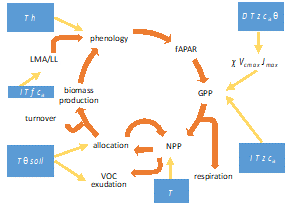Sandy Harrison, LEMONTREE PI, writes:
The LEMONTREE (Land Ecosystem Models based On New Theory, obseRvations and ExperimEnts) project is currently developing a next-generation model of the terrestrial biosphere and its interactions with the carbon cycle, water cycle and climate based on the application of eco-optimality approaches to describe the fundamental processes of plant growth.
Nine of the LEMONTREE PIs, and a number of our students and close collaborators, have been involved in a New Phytologist Tansley Review paper (https://doi.org/10.1111/nph.17558) which came out on 22 July — describing how eco-evolutionary optimality works and how it can be applied to develop robust and parsimonious models of plant behaviour.
Eco-evolutionary optimality (EEO) draws on the power of natural selection to eliminate traits or behaviours that are uncompetitive in a given environment. The development of EEO hypotheses are based on identifying trade-offs that organisms are required to make, for example in land plants between CO2 uptake and water loss.
The core of modelling EEO is therefore the mechanistic links between plant functional traits, their implications for resource demand and acquisition and biogeochemical cycling, and their effect on the plant’s competitiveness.
EEO approaches have primarily been used to analyse and model plant processes at the leaf level, including photosynthesis and primary production, dark respiration, stomatal behaviour, and the leaf economic spectrum.
At the whole plant level, EEO approaches are providing a way to explain the coordination of photosynthetic and hydraulic traits, and this work will ultimately enable us to model the water and carbon cycles in a simple but integrated way.
The Tansley review paper provides examples of ongoing work, but more importantly the motivation behind the LEMONTREE project.
The figure below. (which isn’t alas included in the Tansley review) shows the processes which we are seeking to represent through EEO in LEMONTREE.

LEMONTREE is funded through the generosity of Eric and Wendy Schmidt by recommendation of the Schmidt Futures program. We are very grateful to them for supporting this EEO-based initiative.
